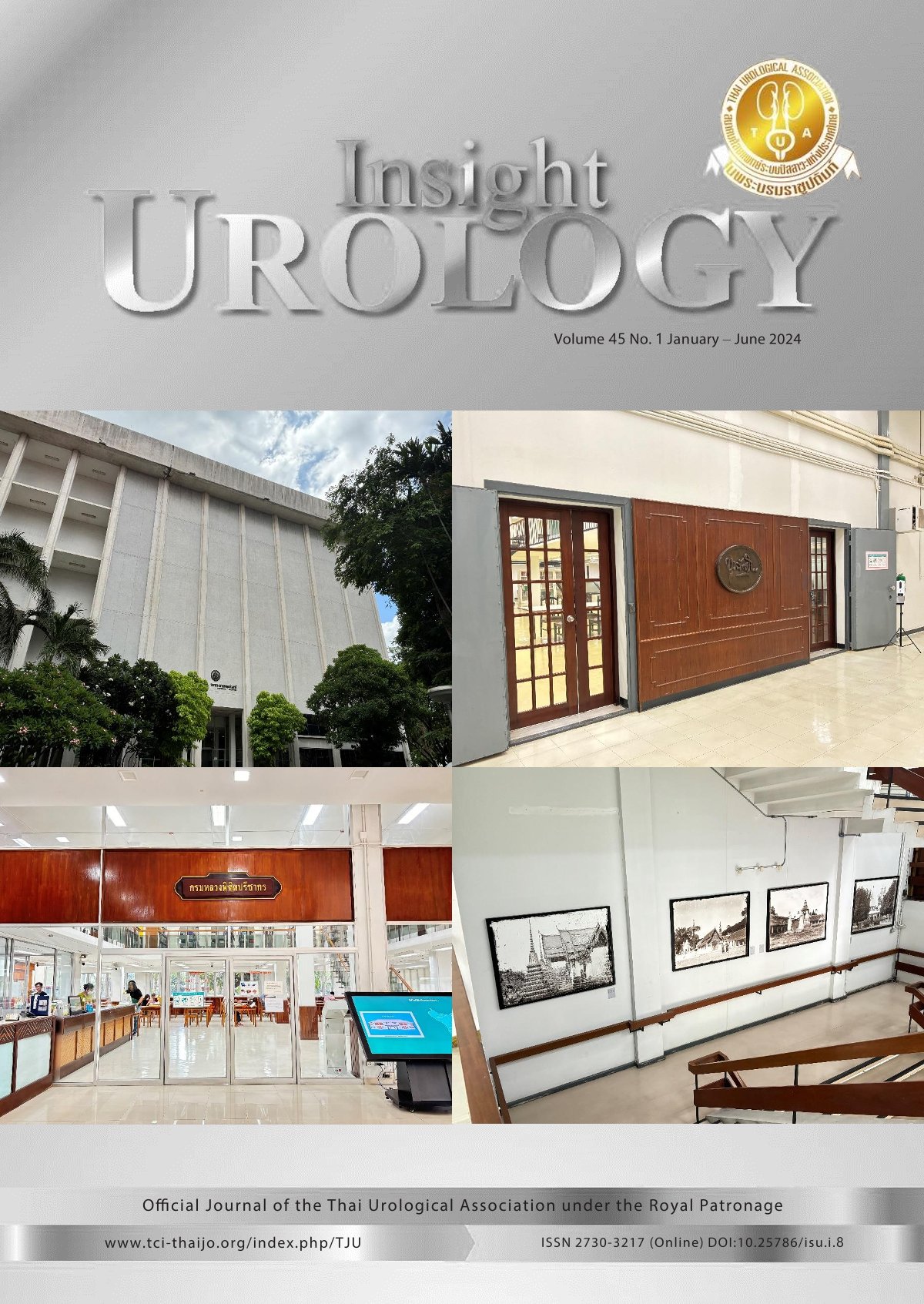Comparative outcomes between adjuvant and salvage radiotherapy in prostate cancer after minimally invasive radical prostatectomy
DOI:
https://doi.org/10.52786/isu.a.79Keywords:
Prostate cancer, adjuvant, salvage, radiotherapy, radical prostatectomyAbstract
Objective: Radical prostatectomy (RP) is the standard treatment in clinically localized prostate cancer. However, the timing of postoperative radiotherapy (RT) in patients with adverse pathologic features or PSA persistence remains controversial. The objective of this study is to compare the survival outcomes and treatment complications between adjuvant radiotherapy (aRT) and salvage radiotherapy (sRT) in patients after minimally invasive RP.
Materials and Methods: This retrospective study reviewed the clinical data in patients who underwent minimally invasive RP in our institution between January 2012 and April 2021. The patients were divided into three groups: no RT, aRT, and sRT. Patient demographic data, pathological reports, RTOG/EORTC toxicity scores, functional outcomes, and survival outcomes were compared between aRT and sRT groups.
Results: A total of 487 patients were included in the study. One-hundred and thirty-three patients (27.3%) received postoperative RT. The pathological stage and positive margin rate were significantly higher in the aRT group. Five-year ADT-free survival (78.8% vs 80%, p = 0.68), 5-year metastasis-free survival (80.2% vs 92.2%, p = 0.38), and 5-year overall survival (97.1% vs 100%, p = 0.68) were no different between groups. There were no significant differences in continence, potency, genitourinary or gastrointestinal toxicities between groups.
Conclusions: Timing of postoperative RT does not affect survival. Functional outcomes and radiation toxicity were comparable between patients undergoing aRT and sRT.
References
Database of Cancer Patients Unit, National Cancer Institute, Department of Medical Services, Ministry of Public Health. Top 10 Most Common Cancer in Males. In: Sangariyawanich E, Pitakngarnkul S, Buasom R, editors. Hospital-Based Cancer Registry 2021. Bangkok: Medical Digital Division, National Cancer Institute; 2022. p. 1.
den Broeck TV, van den Bergh RCN, Arfi N, Gross T, Moris L, Briers E, et al. Prognostic value of biochemical recurrence following treatment with curative intent for prostate cancer: a systematic review. Eur Urol 2019;75:967-87.
Bolla M, van Poppel H, Collette L, van Cangh P, Vekemans K, Da Pozzo L, et al. Postoperative radiotherapy after radical prostatectomy: a randomised controlled trial (EORTC trial 22911). Lancet 2005; 366:572-8.
Bolla M, van Poppel H, Tombal B, Vekemans K, Da Pozzo L, de Reijke TM, et al. Postoperative radiotherapy after radical prostatectomy for high-risk prostate cancer: long-term results of a randomised controlled trial (EORTC trial 22911). Lancet 2012; 380:2018-27.
Thompson IM, Tangen CM, Paradelo J, Lucia MS, Miller G, Troyer D, et al. Adjuvant radiotherapy for pathological T3N0M0 prostate cancer significantly reduces risk of metastases and improves survival: long-term followup of a randomized clinical trial. J Urol 2009;181:956-62.
Kneebone A, Fraser-Browne C, Duchesne GM, Fisher R, Frydenberg M, Herschtal A, et al. Adjuvant radiotherapy versus early salvage radiotherapy following radical prostatectomy (TROG 08.03/ ANZUP RAVES): a randomised, controlled, phase 3, non-inferiority trial. Lancet Oncol 2020;21:1331-40.
Parker CC, Clarke NW, Cook AD, Kynaston HG, Petersen PM, Catton C, et al. Timing of radiotherapy after radical prostatectomy (RADICALS-RT): a randomised, controlled phase 3 trial. Lancet 2020; 396:1413-21.
Sargos P, Chabaud S, Latorzeff I, Magné N, Ben- youcef A, Supiot S, et al. Adjuvant radiotherapy versus early salvage radiotherapy plus short-term androgen deprivation therapy in men with localised prostate cancer after radical prostatectomy (GETUG-AFU 17): a randomised, phase 3 trial. Lancet Oncol 2020;21:1341-52.
Siripalangkanont J, Panumatrassamee K. Comparison of treatment outcomes between laparoscopic and robot-assisted laparoscopic radical prostatectomy in clinically localized prostate cancer, a single-surgeon experience. J Med Assoc Thai 2020; 103:1300-8.
Gospodarowicz MK, Wittekind C, Brierley JD, editors. TNM classification of malignant tumours. 8th ed. New York: Wiley-Blackwell; 2016.
Cox JD, Stetz J, Pajak TF. Toxicity criteria of the Radiation Therapy Oncology Group (RTOG) and the European Organization for Research and Treatment of Cancer (EORTC). Int J Radiat Oncol Biol Phys 1995;31:1341-6.
Thompson IM, Valicenti RK, Albertsen P, Davis BJ, Goldenberg SL, Hahn C, et al. Adjuvant and salvage radiotherapy after prostatectomy: AUA/ASTRO Guideline. J Urol 2013;190:441-9.
Pisansky TM, Thompson IM, Valicenti RK, D’Amico AV, Selvarajah S. Adjuvant and salvage radiation therapy after prostatectomy: ASTRO/AUA Guideline Amendment, Executive Summary 2018. Pract Radiat Oncol 2019;9:208-13.
Mottet N, Bellmunt J, Bolla M, Briers E, Cumberbatch MG, De Santis M, et al. EAU-ESTRO-SIOG Guidelines on Prostate Cancer. Part 1: Screening, diagnosis, and local treatment with curative intent. Eur Urol 2017;71:618-29.
Sineshaw HM, Gray PJ, Efstathiou JA, Jemal A. Declining use of radiotherapy for adverse features after radical prostatectomy: results from the National Cancer Data Base. Eur Urol 2015;68:768-74.
Vale CL, Fisher D, Kneebone A, Parker C, Pearse M, Richaud P, et al. Adjuvant or early salvage radiotherapy for the treatment of localised and locally advanced prostate cancer: a prospectively planned systematic review and meta-analysis of aggregate data. Lancet 2020;396:1422-31.
Woranisarakul V, Leewansangtong S, Dankulchai P, Apiwarodom N, Srinualnad S, Taweemonkongsap T, et al. Oncological outcomes of radiotherapy after radical prostatectomy in Thai patients with prostate cancer. J Med Assoc Thai 2017;100:S179-S85.
Shipley WU, Seiferheld W, Lukka HR, Major PP, Heney NM, Grignon DJ, et al. Radiation with or without antiandrogen therapy in recurrent prostate cancer. N Engl J Med 2017;376:417-28.
Carrie C, Magne N, Burban-Provost P, Sargos P, Latorzeff I, Lagrange JL, et al. Short-term androgen deprivation therapy combined with radiotherapy as salvage treatment after radical prostatectomy for prostate cancer (GETUG-AFU 16): a 112-month follow-up of a phase 3, randomised trial. Lancet Oncol 2019;20:1740-9.
Kiatbamrungpunt C, Nualyong C, Srinualnad S, Leewansangtong S, Taweemonkongsap T, Chaiyaprasithi B, et al. Long term outcomes between adjuvant radiotherapy and combined radiotherapy with hormonal treatment after radical prostatectomy in high risk prostate cancer. Insight Urol 2021;42:7-12.
Spratt DE, Dess RT, Zumsteg ZS, Lin DW, Tran PT, Morgan TM, et al. A systematic review and framework for the use of hormone therapy with salvage radiation therapy for recurrent prostate cancer. Eur Urol 2018;73:156-65.
Downloads
Published
How to Cite
Issue
Section
License
Copyright (c) 2024 Insight Urology

This work is licensed under a Creative Commons Attribution-NonCommercial-NoDerivatives 4.0 International License.



